英语语法解读部分倒装与完全倒装
完全倒装和部分倒装的区别例句

完全倒装和部分倒装的区别例句完全倒装和部分倒装的区别例句如下:一、完全倒装完全倒装是指将句子中的谓语动词全部置于主语之前.完全倒装的句子通常只用一般现在时和过去时.1、Here,There,Now,Then等副词放在句首时,句子要完全倒装,谓语动词常用come,go,be,lie,run等.例如:①There comes the bus!②Now comes your turn.2、表示方位的副词或介词短语置于句首时,句子要完全倒装,句中的谓语动词是come,go等表示运动的动词.①The door opened and in came the headmaster.②Up and up went the prices.③High flew the plane.注意:①上述完全倒装句中主语如为人称代词,应放在动词前面.Here comes Mr.Lee.Here he comes.Auay went the students.Auay they went.②有时为了句子的平衡或强调,将表语置于句首,也属于完全倒装.例如:Gone are the days when we used the foreign oil.二、部分倒装部分倒装是指将谓语动词的一部分如助动或情态动词置于主语之前.1、否定副词如no,not,never,seldom,little,hardly,以及含有no,not的短语放在句首时,句子要部分倒装.①Never in my life have I heard such a thing.②Little did we expect that he could come.③Not a single word did he say at the meeting.④By no means should we do like this.注意:如上述句子中的否定副词不置于句首时,句子结构不倒装.2、以否定词开头的关联结构注意:No sooner…than…,Hardly/scarcely…when…,Not only…but also,Not until…①Not until late in the evening did he come back.②Hardly had he got on the bus when he heard a shout.③Not only did he buy a bike for me but he also sent it to my house.注意:No sooner…than…;hardly…when;not only…but also这类句型,只将前半部分倒装,后半部分用正常语序.3、当only置于句首修饰状语时,句子要部分倒装.①Only in this way can we learn English well.②Only when he is seriously ill does he ever stay in bed.4、so,neither,nor在句首表示“也”或“也不”句子要部分倒装.①Tom is very kind.So am I.②I like English.So does Jack.③I can’t speak English.Nor/Neither can he.注意:so 后主、谓语不倒装表示前面所述内容的肯定、确定.试比较:Tom is very kind.So am I.(两个人,一样情形)Tom is very kind.So he is.(一个人,一种情形)汤姆非常和蔼.他就是如此.5、由as/though引导的让步状语从句,从句形成倒装.①Child as he was,he could speak five languages.②Hard as he work,you can’t support your family.③Try as you do,you will ever win.注意:表语为单数名词时,不定冠词“a”应被省去.She–maker as he was,he was very happy.6、so…that/such…that句型中so,such 位于句首时,句子要部分倒装.①So fast does light travel that it is difficult for us to imagine its speed.7、省略了if 的虚拟条件从句中,主谓形成了部分倒装(虚拟语气的条件句中,省略if 后,had,were,should等应提前)①Had you told me earlier,I could have done something .②Should anyone call,tell him to call in the afternoon.③Were I you,I would try it again.。
英语中的完全倒装和局部倒装
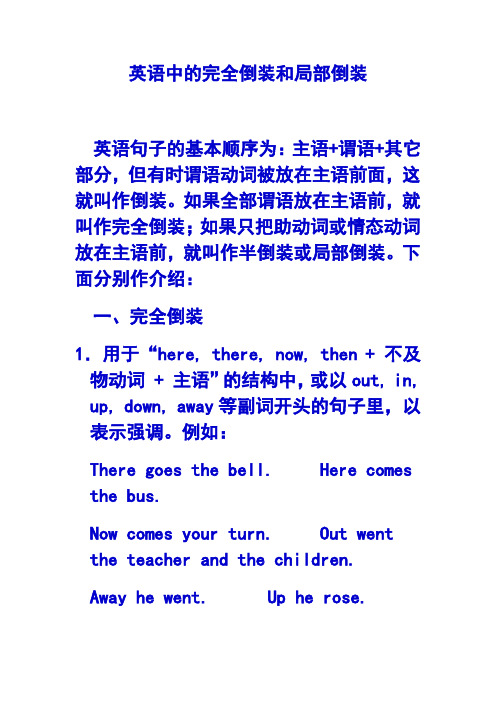
英语中的完全倒装和局部倒装英语句子的基本顺序为:主语+谓语+其它部分,但有时谓语动词被放在主语前面,这就叫作倒装。
如果全部谓语放在主语前,就叫作完全倒装;如果只把助动词或情态动词放在主语前,就叫作半倒装或局部倒装。
下面分别作介绍:一、完全倒装1.用于“here, there, now, then + 不及物动词 + 主语”的结构中,或以out, in, up, down, away等副词开头的句子里,以表示强调。
例如:There goes the bell. Here comes the bus.Now comes your turn. Out went the teacher and the children.Away he went. Up he rose.2.用于“there be”的结构中,例如:There were many boys and girls on the playground just now.There will be a new station near our school.3.当介词短语或地点状语放在句首作状语时,例如:North of the city lies/is a new airport.From the valley came a frightening sound with some cries.4.表语放句首时倒装结构为:“表语+连系动词+主语”,例如:Present at the meeting is our English teacher.Gone are the days when we had a good time at the mountain village.In the middle of the room stand twodesks and some chairs for the party.5.当“so/such… that”结构中的so或such 位于句首时,例如:So beautiful was she that many men would like to dance with her at the party.Such an honest boy is he that he gave back the change to me after shopping.6.用于so, nor, neither开头的句子,表示重复前面的内容,原句的谓语应与前面的谓语动词的时态、形式等相一致。
【英语知识点】部分倒装与完全倒装的区别
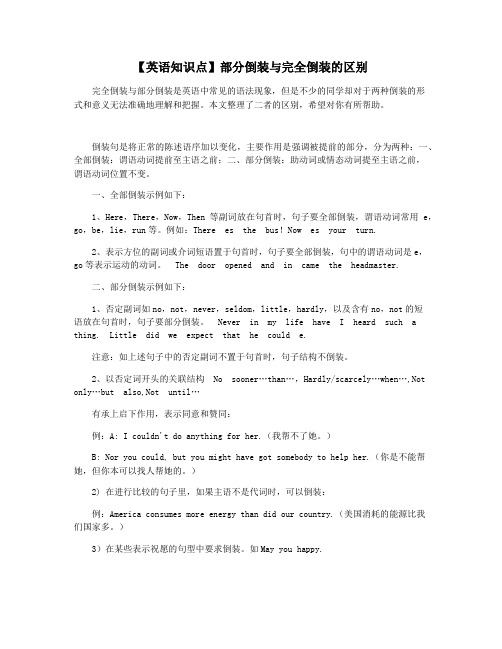
【英语知识点】部分倒装与完全倒装的区别完全倒装与部分倒装是英语中常见的语法现象,但是不少的同学却对于两种倒装的形式和意义无法准确地理解和把握。
本文整理了二者的区别,希望对你有所帮助。
倒装句是将正常的陈述语序加以变化,主要作用是强调被提前的部分,分为两种:一、全部倒装:谓语动词提前至主语之前;二、部分倒装:助动词或情态动词提至主语之前,谓语动词位置不变。
一、全部倒装示例如下:1、Here,There,Now,Then等副词放在句首时,句子要全部倒装,谓语动词常用e,go,be,lie,run等。
例如:There es the bus!Now es your turn.2、表示方位的副词或介词短语置于句首时,句子要全部倒装,句中的谓语动词是e,go等表示运动的动词。
The door opened and in came the headmaster.二、部分倒装示例如下:1、否定副词如no,not,never,seldom,little,hardly,以及含有no,not的短语放在句首时,句子要部分倒装。
Never in my life have I heard such a thing. Little did we expect that he could e.注意:如上述句子中的否定副词不置于句首时,句子结构不倒装。
2、以否定词开头的关联结构No sooner…than…,Hardly/scarcely…when…,Not only…but also,Not until…有承上启下作用,表示同意和赞同:例:A: I couldn't do anything for her.(我帮不了她。
)B: Nor you could, but you might have got somebody to help her.(你是不能帮她,但你本可以找人帮她的。
)2) 在进行比较的句子里,如果主语不是代词时,可以倒装:例:America consumes more energy than did our country.(美国消耗的能源比我们国家多。
部分倒装和全部倒装
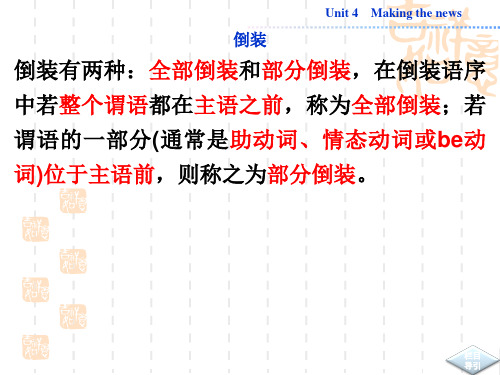
Unit 4 Making the news
4.________ snacks and drinks,but they also brought cards for entertainment when they had a picnic in forest. A.Not only they brought B.Not only did they bring C.Not only brought they D.Not only they did bring 解析: 选B。考查倒装句。not only...but also...连接两个并 列分句时,not only后的分句要用部分倒装
栏目 导引
Unit 4 Making the news
2.表示地点、时间、方向的副词there,here,now, then,in,out,away,down,up,off,next, over,back等词位于句首,谓语动词多是表示运动的 不及物动词come,go,leave,move,run,fly, rush,jump等,而且主语是名词。 Now comes your turn. Up went the arrow into the air. Next comes Tom. 注意 如果此时句子的主语是代词,主谓语序不变。 Here they are!
栏目 导引
注意 当so表示“是的, 确实如此”U,ni其t 4 引Ma出kin的g th句e n子ews 用以对上文内容加以证实或肯定时, 主谓不倒装。
—Betty is a good girl. —Yes, so she is. so +助动词/be动词/情态动词+主语“.......也一样”,
exist,happen,lie,remain,seem,stand等动词。
完全倒装与部分倒装

完全倒装与部分倒装完全倒装和部分倒装是英语语法中常见的句式结构,它们在句子中对主语和谓语进行了调换,使得句子的表达形式有所不同。
本文将对完全倒装和部分倒装进行详细介绍和区分,并给出相关的例句以更好地理解和掌握这两种句式。
一、完全倒装的定义、结构和用法完全倒装是指把句子中的主语和谓语调换位置,使得谓语动词或短语位于主语之前。
完全倒装常用于以下几种情况:1. 在以介词短语作状语的情况下,为了强调地点、时间等状语信息。
例如:Out of the box jumped a cute little kitten.(一只可爱的小猫跳出了盒子。
)In front of the house stood a tall tree.(一棵高大的树矗立在房子前。
)2. 在表示地点或时间的副词或短语放在句首时。
例如:Here comes the bus.(汽车来了。
)Now is the time to act.(是时候采取行动了。
)3. 在以表示否定意义的副词或短语开头的情况下。
例如:Never have I seen such a beautiful sunset.(我从来没有见过如此美丽的日落。
)Not until yesterday did I realize the importance of learning.(直到昨天我才意识到学习的重要性。
)二、部分倒装的定义、结构和用法部分倒装是指只把助动词、情态动词或是be动词短语放在主语前面。
部分倒装常用于以下几种情况:1. 在以否定词开头的句子中,特别是在表示否定意义的副词或短语后面。
例如:Never before have I seen such a magnificent building.(我从未见过如此壮观的建筑。
)Rarely do we have such an opportunity.(我们很少有这样的机会。
)2. 在表示条件的虚拟句型中。
例如:Had I known the truth, I would have acted differently.(要是我当时知道真相,我会采取不同的行动。
完全倒装与部分倒装
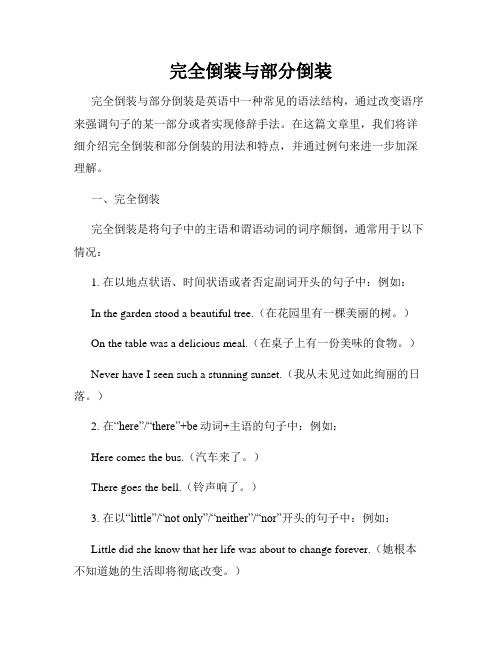
完全倒装与部分倒装完全倒装与部分倒装是英语中一种常见的语法结构,通过改变语序来强调句子的某一部分或者实现修辞手法。
在这篇文章里,我们将详细介绍完全倒装和部分倒装的用法和特点,并通过例句来进一步加深理解。
一、完全倒装完全倒装是将句子中的主语和谓语动词的词序颠倒,通常用于以下情况:1. 在以地点状语、时间状语或者否定副词开头的句子中:例如:In the garden stood a beautiful tree.(在花园里有一棵美丽的树。
)On the table was a delicious meal.(在桌子上有一份美味的食物。
)Never have I seen such a stunning sunset.(我从未见过如此绚丽的日落。
)2. 在“here”/“there”+be动词+主语的句子中:例如:Here comes the bus.(汽车来了。
)There goes the bell.(铃声响了。
)3. 在以“little”/“not only”/“neither”/“nor”开头的句子中:例如:Little did she know that her life was about to change forever.(她根本不知道她的生活即将彻底改变。
)Not only is he intelligent, but he is also kind-hearted.(他不仅聪明,而且心地善良。
)Neither did I agree with his decision, nor did I understand his reasoning.(我既不同意他的决定,也不理解他的理由。
)二、部分倒装部分倒装是将助动词、情态动词或者“be”动词与主语的词序颠倒,同样用于强调句子的某一部分或者实现修辞手法。
常见的部分倒装情况包括:1. 在以否定词开头的句子中:例如:Never have I been so inspired.(我从未如此受到鼓舞。
全部倒装和部分倒装的区别有哪些怎样区分
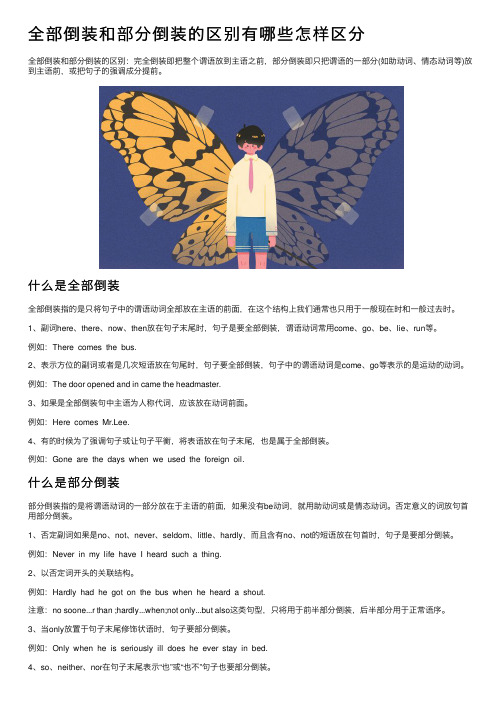
全部倒装和部分倒装的区别有哪些怎样区分全部倒装和部分倒装的区别:完全倒装即把整个谓语放到主语之前,部分倒装即只把谓语的⼀部分(如助动词、情态动词等)放到主语前,或把句⼦的强调成分提前。
什么是全部倒装全部倒装指的是只将句⼦中的谓语动词全部放在主语的前⾯,在这个结构上我们通常也只⽤于⼀般现在时和⼀般过去时。
1、副词here、there、now、then放在句⼦末尾时,句⼦是要全部倒装,谓语动词常⽤come、go、be、lie、run等。
例如:There comes the bus.2、表⽰⽅位的副词或者是⼏次短语放在句尾时,句⼦要全部倒装,句⼦中的谓语动词是come、go等表⽰的是运动的动词。
例如:The door opened and in came the headmaster.3、如果是全部倒装句中主语为⼈称代词,应该放在动词前⾯。
例如:Here comes Mr.Lee. 4、有的时候为了强调句⼦或让句⼦平衡,将表语放在句⼦末尾,也是属于全部倒装。
例如:Gone are the days when we used the foreign oil. 什么是部分倒装部分倒装指的是将谓语动词的⼀部分放在于主语的前⾯,如果没有be动词,就⽤助动词或是情态动词。
否定意义的词放句⾸⽤部分倒装。
1、否定副词如果是no、not、never、seldom、little、hardly,⽽且含有no、not的短语放在句⾸时,句⼦是要部分倒装。
例如:Never in my life have I heard such a thing.2、以否定词开头的关联结构。
例如:Hardly had he got on the bus when he heard a shout. 注意:no soone...r than ;hardly...when;not only...but also这类句型,只将⽤于前半部分倒装,后半部分⽤于正常语序。
部分倒装与全部倒装的适用情课件

结构不同
部分倒装
将谓语的一部分(通常是助动词 或情态动词)放在主语之前,其 余部分放在主语之后。
全部倒装
将整个谓语都放在主语之前,有 时甚至整个句子都放在主语之前 。
用法不同
用于强调否定意义或强调部分 谓语,同时保持句子的平衡。
02
全部倒装
01
部分倒装
用于强调地点、时间、方向等概 念,使句子更加生动有力。
当so/neither+系动 词+主语位于句首时 ,通常需要使用部分 倒装。例如
"If you won't go, neither will I."(如 果你不去,我也不去 。)
"He likes English, so do I."(他喜欢英 语,我也一样。)
虚拟语气中的if省略
在虚拟语气中,如果省略了if, 则需要使用部分倒装。例如
部分倒装)
In front of the house stands a tall tree. (全部倒
装)
01
02
03
04
05
THANKS
部分倒装与全部倒装的适用 情课件
目录
• 部分倒装与全部倒装的定义 • 部分倒装的适用情况 • 全部倒装的适用情况 • 部分倒装与全部倒装的区别 • 部分倒装与全部倒装的练习与解析
01
部分倒装与全部倒装的定 义
部分倒装的定义
谓语动词的一部分放在主语之前
在部分倒装句中,谓语动词的一部分(通常是助动词或情态动词)被放在主语 之前,而其他部分则保持不变。
"Were I you, I would do it."( 如果我是你,我会做这件事。)
全部倒装和部分倒装知识点

全部倒装和部分倒装英语最基本词序“主语部分+谓语部分”通常十分固定。
如果把谓语动词放在主语前面,这就叫做倒装。
将谓语动词完全移至主语之前,称为完全倒装;如果只是把助动词或情态动词放在主语之前,称为部分倒装。
一、全部倒装1.以here, there,now,then开头的句子,谓语动词要放在句子主语之前。
这种句子谓语动词常是不及物动Here comes the train! There goes the bell!注意:如果句子的主语是人称代词,则不能使用倒装结构。
Here it comes! There it goes!2.有些动词短语以副词out,in,up,down,away结尾,构成不及物动词短语。
为了使句子更形象,常将这些副词提前到句首。
句中的谓语动词要放在句子主语的前面,构成全部倒装。
(注意,句子主语是名词。
如果是人称代词,不能用倒装结构。
)Up went the rocket. Up it went.3.为了强调表示地点的介词短语,常将这个介词短语放在句首,构成全部倒装。
注意,这时句子的谓语动词通常是不及物动词。
In the front of the lecture hall sat the speaker.4.表语置于句首,且主语较长或结构较复杂的句子要用全部倒装。
Gone are the days when we had nothing to eat.5.so/neither/nor表示前面所说的情况也适合于后者,其倒装结构为“so /neither/nor+助动词/系动词/情态动词+主语”(so表示肯定意义,neither/nor表示否定意义)。
She has finished her homework,so has her brother. She hasn’t gone there,neither/nor has he.但如果so表强调,即强调前面所说的情况的真实性时,其结构是“so+主语+助动词/系动词/情态动词”,主语同前一个句子的主语指的是同一人或物。
英语全部倒装与部分倒装区别讲解 多种比对

全部倒装与部分倒装区别英语句子一般主语在前,谓语在后,但有时因为语法结构的要求或由于修辞的要求,要改变句子的自然语序,把一些本应置于主语之后的成分提前,我们称这种语序为倒装语序。
解释1:部分倒装—是指将谓语的一部分如系动词,助动词或情态动词倒装至主语之前。
如果句子的谓语没有助动词或情态动词,则需添加助动词do, does或did,并将其置于主语之前。
解释2:完全倒装即把整个谓语放到主语之前In came the teacher and the class began. (老师走了进来,然后开始上课。
)部分倒装即只把谓语的一部分(如助动词、情态动词等)放到主语前,或把句子的强调成分提前。
Nor did he let the disease stop him from living the kind of life he has always dreamt about(疾病没有使他放弃过上梦想中的生活)解释3:为了表示强调,经常将never等否定副词或by no means等杏定词组放在句首,此时句子要求将系动词、助动词或情态动词放在主语之前,而谓语部分位置不变,这就是部分倒装。
Not until yesterday did little John change his mind.直到昨天小约翰才改变主意。
完全倒装是主语和谓语完全颠倒。
如;Here comes the bus. 公共汽车来了。
There goes the bell. 铃响了。
解释4:英语句子的自然语序是“主语+ 谓语”。
如果将谓语的全部或一部分放在主语之前,这种语序被称为“倒装”。
谓语全部放在主语之前,为全部倒装;只把助动词,连系动词或情态动词放在主语之前,为部分倒装。
倒装的原因,一是语法结构的需要(如某些疑问句);二是为了强调;三是保持句子的平衡或是上下文紧密相接解释5:英语句子的结构一般是“主语+ 谓语”,语法上称这种语序为自然语序。
完全倒装与部分倒装(精选)
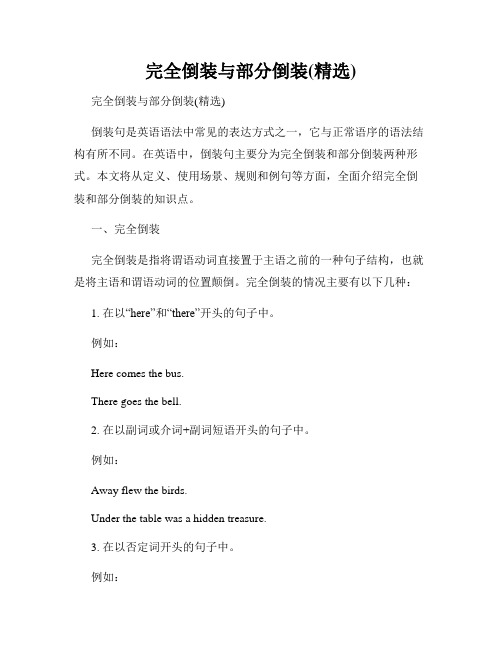
完全倒装与部分倒装(精选)完全倒装与部分倒装(精选)倒装句是英语语法中常见的表达方式之一,它与正常语序的语法结构有所不同。
在英语中,倒装句主要分为完全倒装和部分倒装两种形式。
本文将从定义、使用场景、规则和例句等方面,全面介绍完全倒装和部分倒装的知识点。
一、完全倒装完全倒装是指将谓语动词直接置于主语之前的一种句子结构,也就是将主语和谓语动词的位置颠倒。
完全倒装的情况主要有以下几种:1. 在以“here”和“there”开头的句子中。
例如:Here comes the bus.There goes the bell.2. 在以副词或介词+副词短语开头的句子中。
例如:Away flew the birds.Under the table was a hidden treasure.3. 在以否定词开头的句子中。
例如:Never have I seen such a beautiful sunset.Not only did he pass the exam, but he also got the highest score.4. 在以“only”开头的句子中。
例如:Only in this way can we solve the problem.Only when we work together can we achieve success.二、部分倒装部分倒装是指将助动词、情态动词或连系动词置于主语之前的一种句子结构。
部分倒装常常出现在以下情况下:1. 在以否定词开头的句子中。
例如:Never have I been so disappointed.At no time did she mention the incident.2. 在以“so”开头表示结果的句子中。
例如:So excited was he that he couldn't fall asleep.So tired was she that she couldn't continue the journey.3. 在以“not only...but also...”开头的句子中。
高中语法辨析倒装句的完全与部分倒装
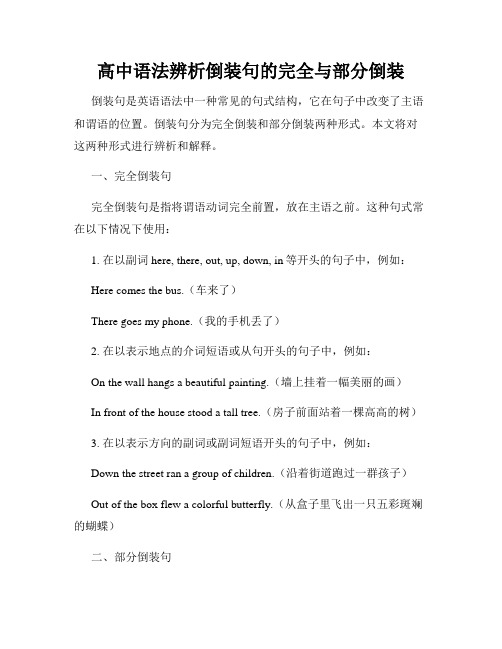
高中语法辨析倒装句的完全与部分倒装倒装句是英语语法中一种常见的句式结构,它在句子中改变了主语和谓语的位置。
倒装句分为完全倒装和部分倒装两种形式。
本文将对这两种形式进行辨析和解释。
一、完全倒装句完全倒装句是指将谓语动词完全前置,放在主语之前。
这种句式常在以下情况下使用:1. 在以副词here, there, out, up, down, in等开头的句子中,例如:Here comes the bus.(车来了)There goes my phone.(我的手机丢了)2. 在以表示地点的介词短语或从句开头的句子中,例如:On the wall hangs a beautiful painting.(墙上挂着一幅美丽的画)In front of the house stood a tall tree.(房子前面站着一棵高高的树)3. 在以表示方向的副词或副词短语开头的句子中,例如:Down the street ran a group of children.(沿着街道跑过一群孩子)Out of the box flew a colorful butterfly.(从盒子里飞出一只五彩斑斓的蝴蝶)二、部分倒装句部分倒装句是指将助动词或情态动词与主语之间的其他成分倒装,谓语动词仍然位于主语之后。
这种句式常在以下情况下使用:1. 在以表示否定意义的副词或词组开头的句子中,例如:Never have I seen such a beautiful sunset.(我从未见过如此美丽的日落)Under no circumstances should you give up.(无论如何,你都不应该放弃)2. 在以谓语动词的否定形式开头的句子中,例如:Not only does she play the piano, but she also sings.(她不仅会弹钢琴,还会唱歌)No sooner had I arrived home than it started raining.(我一到家就开始下雨)3. 在以“so + 形容词/副词 + 助动词/情态动词”结构开头的句子中,例如:So beautiful is the scenery that I want to stay here forever.(风景如此美丽,我想永远呆在这里)So quickly can he solve the math problem that it astonishes everyone.(他能如此快地解决这道数学题,让每个人都惊讶)总结:完全倒装句和部分倒装句在使用场景和结构上有所不同。
部分倒装和完全倒装的区别

部分倒装和完全倒装的区别倒装句是将正常的陈述语序加以变化,主要作用是强调被提前的部分,分为两种:一、全部倒装:谓语动词提前至主语之前;二、部分倒装:助动词或情态动词提至主语之前,谓语动词位置不变。
扩展资料英语当中的倒装是一个非常重要的知识点,我们一定要看一下,倒装句型分成两类:部分倒装和完全倒装。
顾名思义,所谓部分倒装指的是谓语的一部分,跑到了主语的前面,部分倒装过来了,那主要的部分,也就是谓语主要的部分,还是在主语之后。
我们举个例子。
Only in this way can we learn English well. 只有用这种方法,我们能把英语学好。
Only in this way,当我们要强调这个状语的时候,Only in this way,我会用到部分倒装,can we learn English well. 大家注意看一下,can we learn 主语是we,learn是谓语。
跑到了后面。
它前面是一个助动词,can we learn,也就是说谓语的一部分跑到了主语之前,主要的谓语还是在后边的,所以我们把这个叫做部分倒装。
再过一遍这个例句。
Only in this way can we learn English well.接下来完全倒装那就更好理解了。
那就是完全的,整个谓语跑到主语之前。
比如说 In this classroom sits a student.学生坐在教室里,但是这里我要强调往前放的部分,也就是in the classroom。
然后我再说谓语叫做sits,然后再是主语 student。
好,这句话正常的顺序谁都知道叫做A student sits in the classroom。
而我这个时候用完全倒装。
Student作为主语,sits作为谓语,完全发生了顺序的颠倒,我们就叫完全倒装。
不管怎么样,部分倒装、完全倒装,它们的功能是一样的,是为了强调,强调往前放的部分。
完全倒装与部分倒装
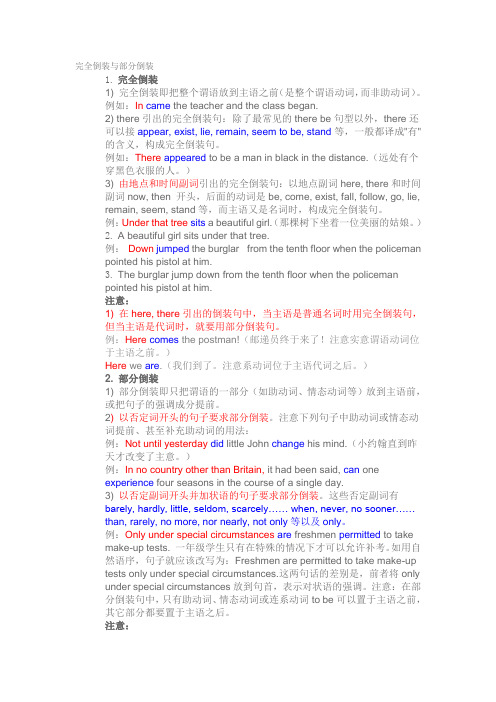
完全倒装与部分倒装1.完全倒装1) 完全倒装即把整个谓语放到主语之前(是整个谓语动词,而非助动词)。
例如:In came the teacher and the class began.2) there引出的完全倒装句:除了最常见的there be句型以外,there还可以接appear, exist, lie, remain, seem to be, stand等,一般都译成"有"的含义,构成完全倒装句。
例如:There appeared to be a man in black in the distance.(远处有个穿黑色衣服的人。
)3) 由地点和时间副词引出的完全倒装句:以地点副词here, there和时间副词now, then 开头,后面的动词是be, come, exist, fall, follow, go, lie, remain, seem, stand等,而主语又是名词时,构成完全倒装句。
例:Under that tree sits a beautiful girl.(那棵树下坐着一位美丽的姑娘。
)2. A beautiful girl sits under that tree.例:Down jumped the burglar from the tenth floor when the policeman pointed his pistol at him.3. The burglar jump down from the tenth floor when the policemanpointed his pistol at him.注意:1) 在here, there引出的倒装句中,当主语是普通名词时用完全倒装句,但当主语是代词时,就要用部分倒装句。
例:Here comes the postman!(邮递员终于来了!注意实意谓语动词位于主语之前。
)Here we are.(我们到了。
完全倒装与部分倒装通用版
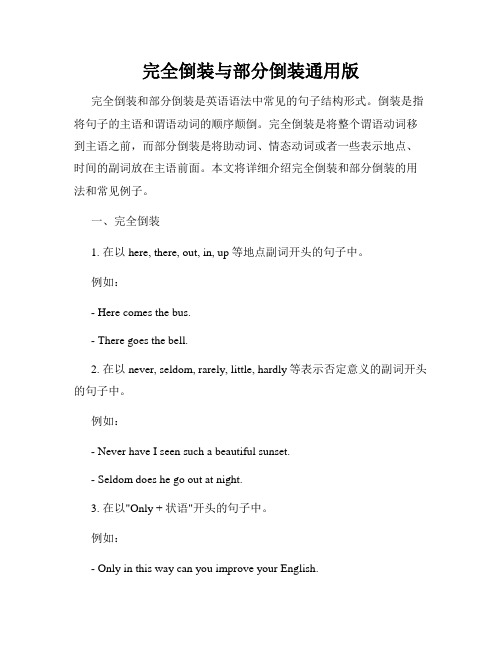
完全倒装与部分倒装通用版完全倒装和部分倒装是英语语法中常见的句子结构形式。
倒装是指将句子的主语和谓语动词的顺序颠倒。
完全倒装是将整个谓语动词移到主语之前,而部分倒装是将助动词、情态动词或者一些表示地点、时间的副词放在主语前面。
本文将详细介绍完全倒装和部分倒装的用法和常见例子。
一、完全倒装1. 在以here, there, out, in, up等地点副词开头的句子中。
例如:- Here comes the bus.- There goes the bell.2. 在以never, seldom, rarely, little, hardly等表示否定意义的副词开头的句子中。
例如:- Never have I seen such a beautiful sunset.- Seldom does he go out at night.3. 在以"Only + 状语"开头的句子中。
例如:- Only in this way can you improve your English.- Only by working hard can we achieve success.4. 在以否定词开头的句子中,如never, not, no sooner等。
例如:- Never had I tasted such delicious food.- Not until the exam is over will we be able to relax.5. 在以“so/such + adj./adv. + that”开头的句子中。
例如:- So loud was the music that we couldn't hear each other.- Such is his talent that he can play multiple instruments.6. 在以“here/now + 系动词 + 主语”开头的句子中。
英语部分倒装与完全倒装的区别

英语部分倒装与完全倒装的区别很多同学都学习过英语倒装句,那么部分倒装与完全倒装有什么不同之处?部分倒装与完全倒装的不同完全倒装:完全倒装即把整个谓语放到主语之前(是整个谓语动词,而非助动词)。
部分倒装:部分倒装即只把谓语的一部分(如助动词、情态动词等)放到主语前,或把句子的强调成分提前。
部分倒装与全部倒装的区别在于用法。
完全倒装表示地点、时间或方位的副词或介词短语(here, there, now, then, up, down, away, off, in, out, in the room, on the wall等)置于句首,且主语为名词时。
完全倒装的时态常用一般现在时或一般过去时,不用进行时。
所以如果你遇见地点状语提前,但是没有完全倒装的时候,看看是不是时态的问题造成了这种不倒装的情形。
部分倒装1.含有否定意义的副词或介词短语(never, seldom, little, hardly, by no means, at no time等)位于句首时。
2.only修饰介词短语、副词或状语从句,且置于句首时。
3.so/neither+助动词/be动词/情态动词+主语,意为“……也是如此/……也不”。
4.hardly...when, no sooner...than, not only...but(also)等引导两个分句时,若hardly, no sooner, not only位于句首,前一个分句用部分倒装,后一个分句不变。
5.not until...置于句首时,主句需部分倒装。
6.so...that...和such...that...句式中,so或such及其所修饰的成分置于句首时,主句需部分倒装。
7.though/as引导让步状语从句时通常用倒装结构,其结构为:名词/形容词/副词/动词+though/as+主谓结构。
8.当if引导的虚拟条件从句中含有had,were或should等时,如将if省略,则要将had,were或should提到主语之前。
全部倒装和部分倒装知识点

全部倒装和部分倒装知识点倒装是英语中的一种语法结构,常见于特殊句型或句子的词序变换。
倒装分为全部倒装和部分倒装两种形式。
全倒装是指谓语动词与主语互换位置,而部分倒装是指谓语动词中的助动词或其他辅助动词与主语互换位置。
一、全部倒装1. 在以表示方向、距离、时间等副词开头的句子中,常用全部倒装结构,即把谓语动词完全提到主语之前。
常见的副词有here, there, now, then等。
例如:There goes the bell. (这是句确句式,意思是“铃响了。
”)2.以否定副词开头的句子也常用全部倒装。
例如:Never have I seen such a beautiful sunset. (我从未见过如此美丽的日落。
)Rarely do we go to the cinema. (我们很少去电影院。
)3.在倒装句中,当句首为状语从句时,主句也要全部倒装。
例如:If only I had known the truth, I would have acted differently. (要是我早知道真相,我会有所不同的行动。
)When she arrived, so did he. (她到达时,他也到了。
)4.在以“介词+疑问词”开头的句子中,常用全部倒装。
例如:By what means was he able to escape? (他是用什么方法逃脱的?) With whom did you go to the party? (你和谁一起去的派对?)二、部分倒装1. 当句子以否定词或含有否定意义的词开头时,助动词或系动词要与主语调换位置,并在助动词或系动词后加not。
例如:They are not studying English. (他们不在学英语。
)2. 当so/such引导的结果状语从句位于句首时,要进行倒装。
例如:So tired was he that he fell asleep immediately. (他太累了,以至于立刻睡着了。
句子的倒装与部分倒装
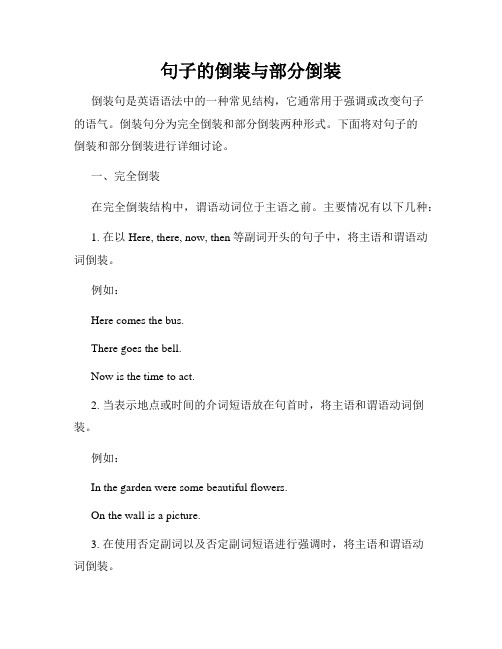
句子的倒装与部分倒装倒装句是英语语法中的一种常见结构,它通常用于强调或改变句子的语气。
倒装句分为完全倒装和部分倒装两种形式。
下面将对句子的倒装和部分倒装进行详细讨论。
一、完全倒装在完全倒装结构中,谓语动词位于主语之前。
主要情况有以下几种:1. 在以Here, there, now, then等副词开头的句子中,将主语和谓语动词倒装。
例如:Here comes the bus.There goes the bell.Now is the time to act.2. 当表示地点或时间的介词短语放在句首时,将主语和谓语动词倒装。
例如:In the garden were some beautiful flowers.On the wall is a picture.3. 在使用否定副词以及否定副词短语进行强调时,将主语和谓语动词倒装。
例如:Never have I seen such a beautiful sunset.Not only is he a great musician, but also a talented writer.4. 在祈使句中,将谓语动词放在句首。
例如:Go away!Be quiet!二、部分倒装部分倒装句是指将助动词、情态动词或者be动词与主语之间的顺序颠倒。
常见情况包括:1. 否定副词或者词组放在句首进行强调时,将助动词、情态动词或be动词与主语之间的顺序颠倒。
例如:Under no circumstances should you give up.By no means will I forgive him.2. 在条件句中,将主语和谓语中的助动词、情态动词或者be动词倒装。
例如:Had I known the truth, I wouldn't have trusted him.Should you need any help, feel free to ask.3. 在含有only, hardly, little, seldom等词的句子中,将助动词、情态动词或be动词与主语之间的顺序颠倒。
英语全部倒装与部分倒装区别讲解 多种比对

全部倒装与部分倒装区别英语句子一般主语在前,谓语在后,但有时因为语法结构的要求或由于修辞的要求,要改变句子的自然语序,把一些本应置于主语之后的成分提前,我们称这种语序为倒装语序。
解释1:部分倒装—是指将谓语的一部分如系动词,助动词或情态动词倒装至主语之前。
如果句子的谓语没有助动词或情态动词,则需添加助动词do, does或did,并将其置于主语之前。
解释2:完全倒装即把整个谓语放到主语之前In came the teacher and the class began. (老师走了进来,然后开始上课。
)部分倒装即只把谓语的一部分(如助动词、情态动词等)放到主语前,或把句子的强调成分提前。
Nor did he let the disease stop him from living the kind of life he has always dreamt about(疾病没有使他放弃过上梦想中的生活)解释3:为了表示强调,经常将never等否定副词或by no means等杏定词组放在句首,此时句子要求将系动词、助动词或情态动词放在主语之前,而谓语部分位置不变,这就是部分倒装。
Not until yesterday did little John change his mind.直到昨天小约翰才改变主意。
完全倒装是主语和谓语完全颠倒。
如;Here comes the bus. 公共汽车来了。
There goes the bell. 铃响了。
解释4:英语句子的自然语序是“主语+ 谓语”。
如果将谓语的全部或一部分放在主语之前,这种语序被称为“倒装”。
谓语全部放在主语之前,为全部倒装;只把助动词,连系动词或情态动词放在主语之前,为部分倒装。
倒装的原因,一是语法结构的需要(如某些疑问句);二是为了强调;三是保持句子的平衡或是上下文紧密相接解释5:英语句子的结构一般是“主语+ 谓语”,语法上称这种语序为自然语序。
- 1、下载文档前请自行甄别文档内容的完整性,平台不提供额外的编辑、内容补充、找答案等附加服务。
- 2、"仅部分预览"的文档,不可在线预览部分如存在完整性等问题,可反馈申请退款(可完整预览的文档不适用该条件!)。
- 3、如文档侵犯您的权益,请联系客服反馈,我们会尽快为您处理(人工客服工作时间:9:00-18:30)。
[初中英语倒装句讲解]英语语法——解读部分倒装与完全倒装篇一: 英语语法——解读部分倒装与完全倒装部分和完全倒装有什么不同?看看下面的讲解是否明白?部分只需要把助动词提前其他句子结果不变全部倒装呢则是要把谓语提前句子其他位置不边部分倒装所谓的助动词意思我举个小列子你就懂了I went to home .这里谓语就是went相应的组动词就是did部分倒装:Did I go to home.完全倒装:Went I to home.1. 完全倒装1) 完全即把整个谓语放到主语之前。
there引出的完全倒装句:除了最常见的there be句型以外,there还可以接appear, exist, lie, remain, seem to be, stand等,一般都译成”有”的含义,构成完全倒装句。
例如:There appeared to be a man in black in the distance.3) 由地点和时间副词引出的完全句:以地点副词here, there和时间副词now, then 开头,后面的动词是be, come, exist, fall, follow, go, lie, remain, seem, stand等,而主语又是名词时,构成完全倒装句。
例:Under that tree sits a beautiful girl. 例:_________ from thetenth floor when the policeman pointed his pistol at him.A) Jumped down the burglar B) Down the burglar jumpedC) The burglar jumps down D) Down jumped the burglar答案是D) Down jumped the burglar。
因为地点状语Down位于句首应该用完全倒装,整个谓语动词应位于主语之前。
C) The burglar jumps down虽然是自然语序,但时态错误,应该用和时间状语从句一致的过去时,而不是现在时。
注意:1) 在here, there引出的倒装句中,当主语是普通名词时用完全倒装句,但当主语是代词时,就要用部分句。
例:Here comes the postman! Here we are.2) 注意正语序和语序的语气、意义是区别:例:Here is the picture I love.The picture I love is here.3) 当主语是代词,谓语是系动词,表语是说明性的词、词组和定语从句时,可以使用完全倒装句,起强调作用。
例:Lucky is he who has been enrolled into a famous university.2. 部分倒装1) 部分即只把谓语的一部分放到主语前,或把句子的强调成分提前。
[]例:_______ right now, she would get there on Sunday.A) Would she leave B) if she leaveC) were she to leave D) If she had left结合选项,全句的意思是:“如果她立刻就走,她就能在星期天到达那里”。
答案是C。
2) 以否定词开头的句子要求部分倒装。
注意下列句子中助动词或情态动词提前、甚至补充助动词的用法:例:Not until yesterday did little John change his mind. 例:In no country ______ Britain, it had been said, can one experience four seasons in the course of a single day.A) better than B) more than C) other than D) rather than本题是个倒装句,答案是C) other than。
no other than意思是“正是、就是”;而rather than的意思是“宁愿……而不……;而不是”。
3) 以否定副词开头并加状语的句子要求部分倒装。
这些否定副词有barely, hardly, little, seldom, scarcely…… when, never, no sooner…… than, rarely, no more, nor nearly, not only等以及only。
例:Only under special circumstances _________ to take make-up tests.A) are freshmen permitted C) permitted are freshmenB) freshmen are permitted D) are permitted freshmen全句的意思是:“一年级学生只有在特殊的情况下才可以允许补考。
”本陈述句以only开始,后面接状语,应当用部分倒装句。
所以答案是A) are freshmen permitted。
如用自然语序,本题所在的句子就应该改写为:Freshmen are permitted to take make-up tests only underspecial circumstances.这两句话的差别是,前者将only under special circumstances放到句首,表示对状语的强调。
注意:在部分倒装句中,只有助动词、情态动词或连系动词to be可以置于主语之前,其它部分都要置于主语之后。
注意:a) 如果含有从句时,只要求主句倒装:例:Only after he had spoken out the word did he realize he had made a big mistake.b) 如果上述否定副词出现在强调句型中的前半部分,不用倒装:例:It was not until he went abroad that he know the truth of the fact.c) 如果hardly, scarcely后面接的是any, ever, at all时,意义类似almost no/ not/ never,则无须。
例:Hardly any people having been invited went there.4) 由no matter how, however和how引导的状语从句要求部分,因为形容词或副词通常紧跟在这三个引导词后面,然后才是主语和谓语,形成形式上的部分句:例:I know nothing about this river, neither how long, how wide nor how deep it is.由as引导的部分句:a) 当as作为比较意义时,即用于as + adj./ adv. + as结构中时,如果把第一个as省略掉,就形成部分倒装句。
例:Cautious as the rest of her family , she didn’t seem willing to give an immediate reply to my question.She ran down the stairs, quick as a rabbit .b) 当as引导让步状语时,和although, though一样,当用作“尽管”之义时,可以用于部分倒装句。
[]例:_______, there was no hope of her being able to sleep.A) As she was exhausted B) If she was exhaustedC) Exhausted though she was D) Now that she was exhausted答案是C) Exhausted though she was。
从属连词as, though可以用于让步状语从句中。
这种从句必须以形容词、名词或动词原形开头,主语必须位于从句之后。
D) Now that she was exhausted里的引导词Now that表示“既然”;B) If she was exhausted表示条件“如果”;A) As she was exhausted表示“由于”,都与后面句子的意思不通顺。
c) 表示原因时,为了强调起见,也可以倒装。
例:Tired as he was, we decided not to disturb him. d) 等于so时,意义是“也,是”例:She worked hard, so/ as did her husband.3. 其它情况的倒装句1) so, neither, nor除了构成上述倒装句以外,还可以取代上文出现的名词、形容词甚至整句话,构成完全句或部分倒装句。
但这两种倒装的意义不同。
a) 当so表示“也,相同,那样”时,通常表示对前一句肯定句的赞同、一致内容,要求使用完全句:例:I asked him to complete the experiment before five, so he did .b) so /such ……that句型可以构成部分倒装句,表示强调so /such 和that之间的部分:例:So unreasonable was his price that everybody startled.To such length did she go in rehearsal that the two actors walked out.c) neither和nor共有4种形式,其含义分别为:完全时:表示”不”,和上文a)用法正好相反,表示对前一句否定句的赞同或一致内容。
例:You don’t know what to do now, neither/ nor do I . 和其它否定副词连用,表示”“,要求用完全倒装句:例:The besieged enemy could not advance, nor / neither could they retreat.注意:若把这句话改成:”The besieged enemy could neither advance nor retreat.”就不必。
例:She never laughed, ______ lose her temper.A) or she ever did B) nor did she everC) or did she ever D) nor she ever did本题的句子是一个并列句,全句意思是:”她从来不大声笑,没有发过脾气”。
